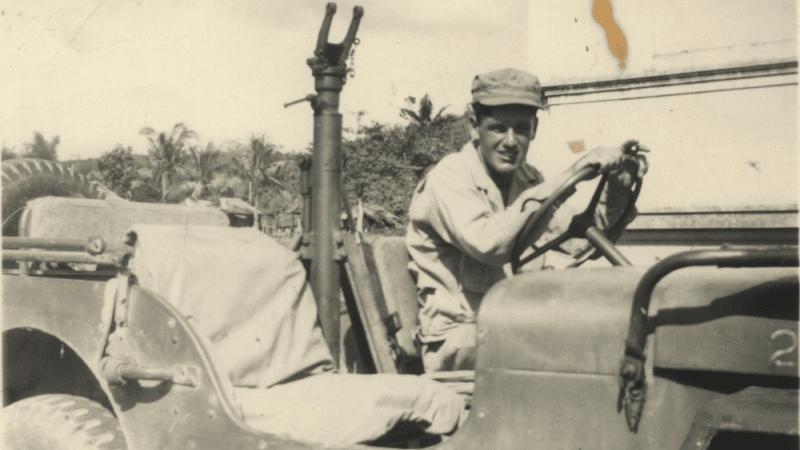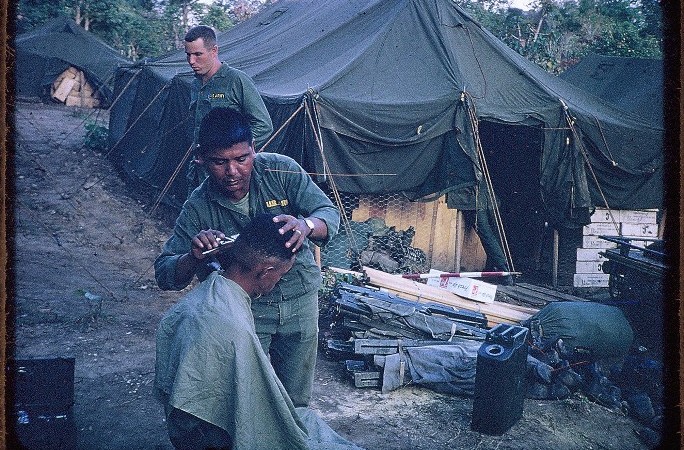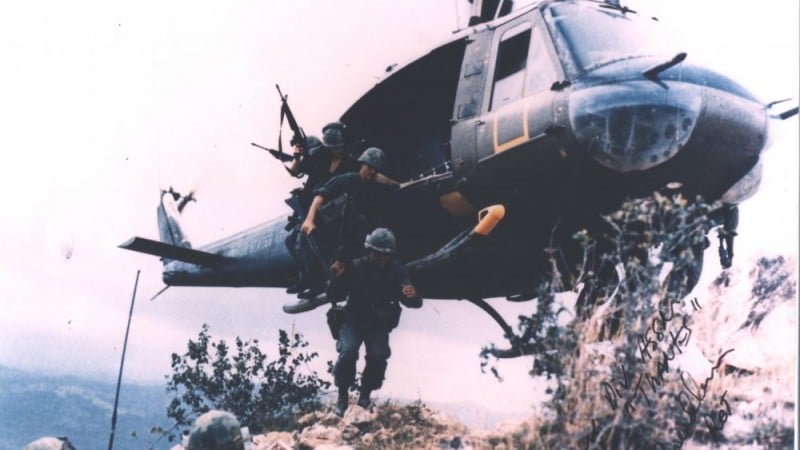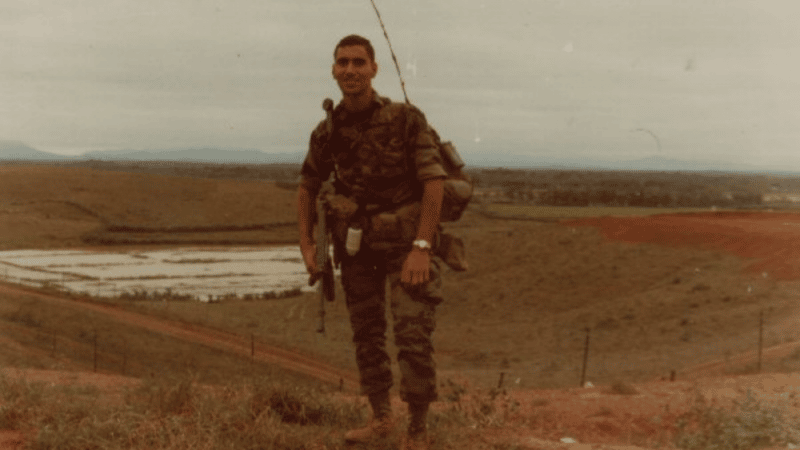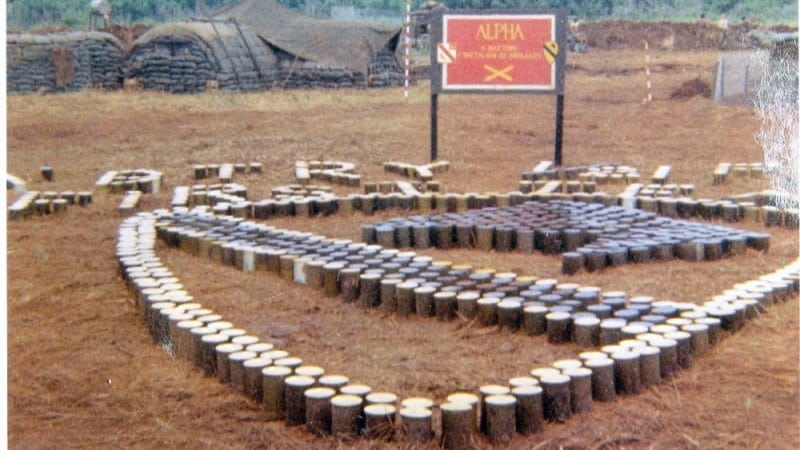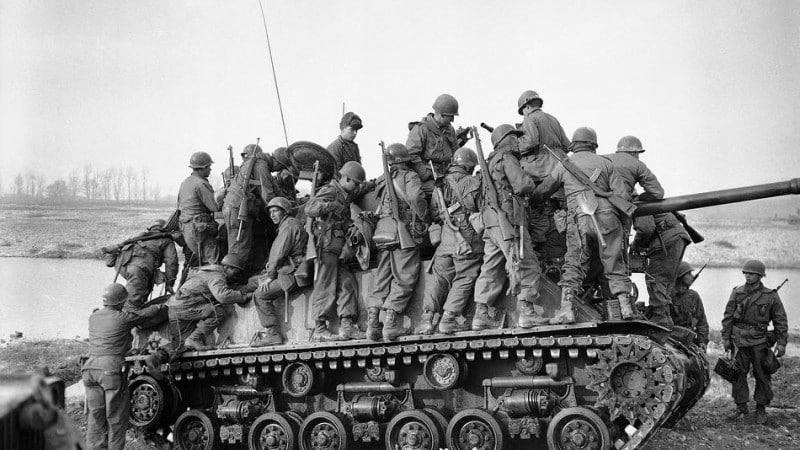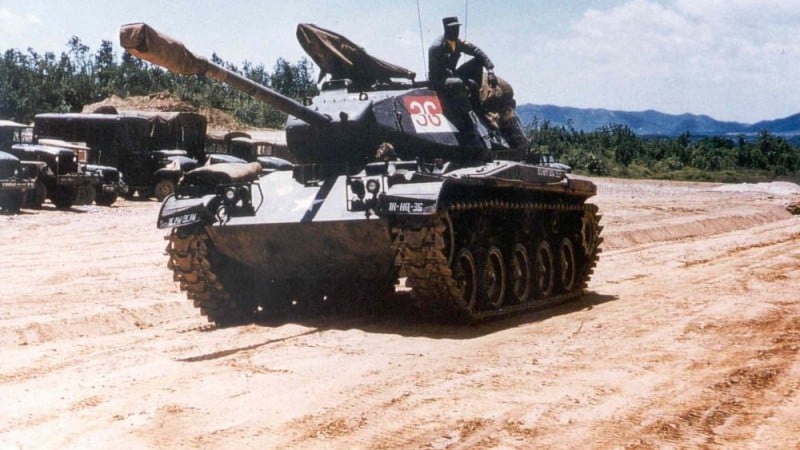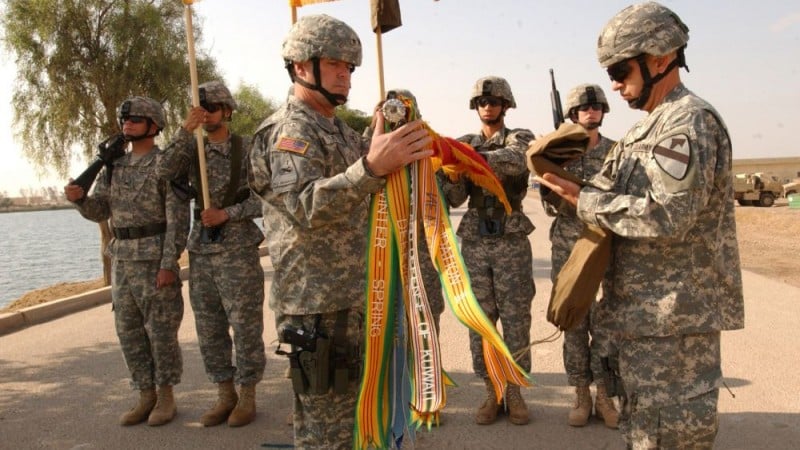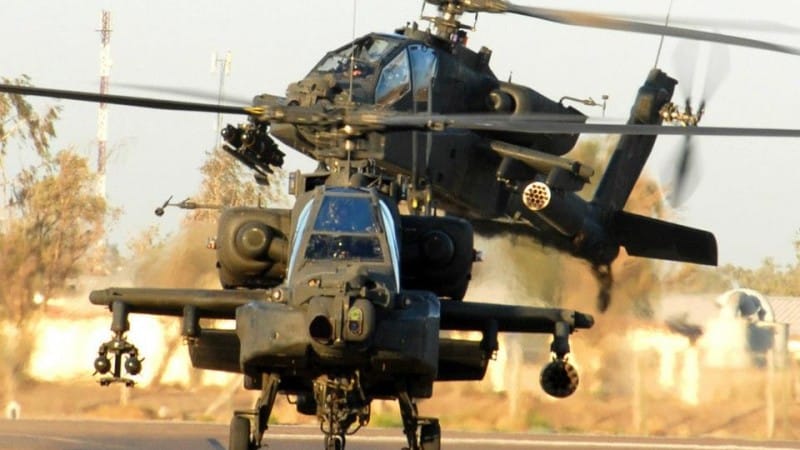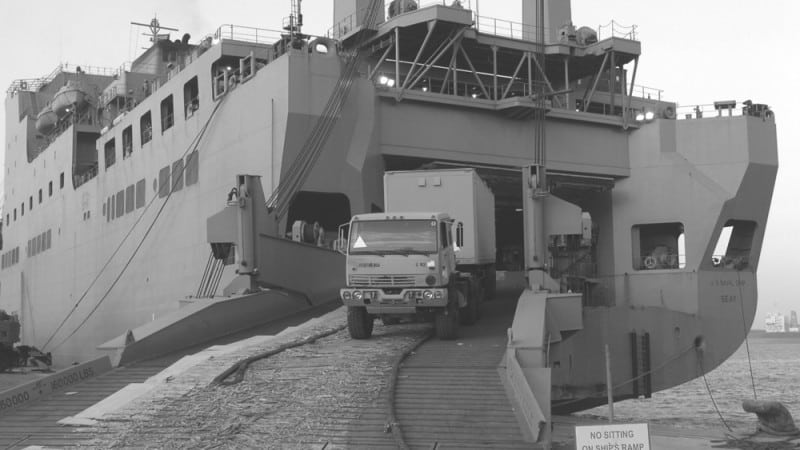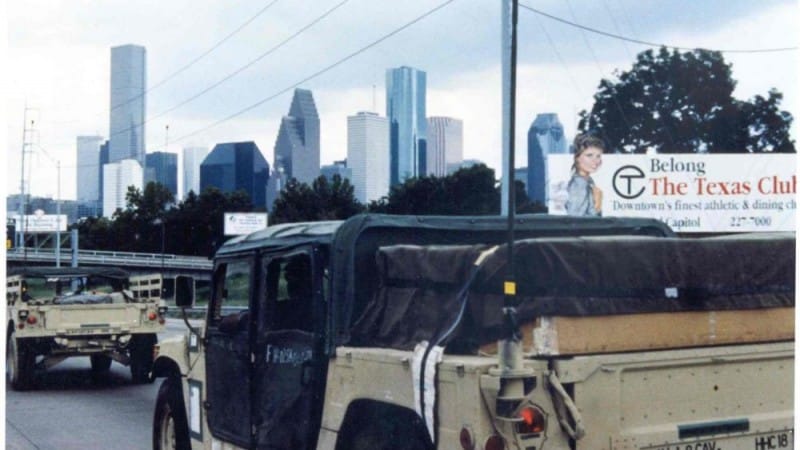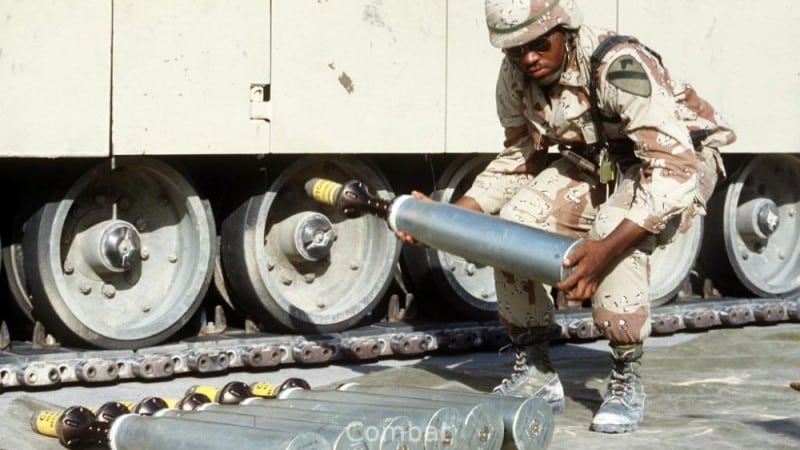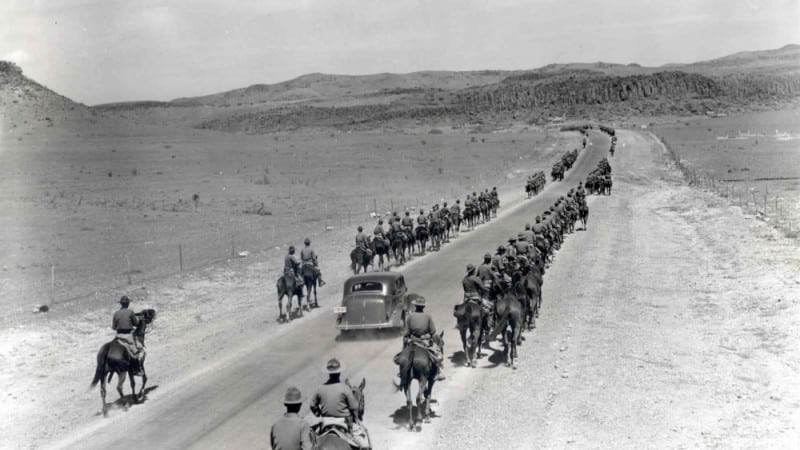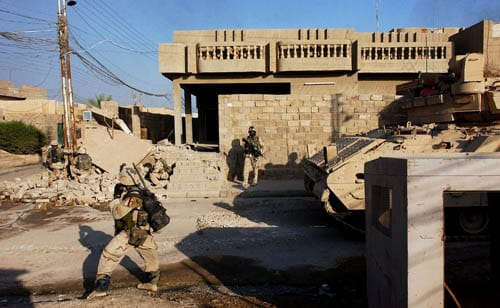12th Cavalry Regiment
Semper Paratus (Always Ready)

Information compiled and composed by William H. Boudreau
On 02 February 1901, the 12th Cavalry Regiment was constituted in the Regular Army. On 08 February 1901, the organization of the regiment was started at Fort Sam Houston, Texas and was completed on 29 June 1901, under the command of Colonel James N. Wheelan.
During the years of 1901 and 1902, following their organization at Ft. Sam Houston, companies of the regiment moved to Fort Clark, Fort Bliss and Fort McIntosh, all located in Texas. In 1903, the regiment was sent, by squadrons, to the Philippines, completing the change of station on 30 August 1903.
In 1905, the regiment was ordered back to the United States. By 13 September 1905, the last contingent of the regiment arrived at their assigned post, Fort Oglethorpe, Georgia. In 1909, following four years of garrison duty at Fort Oglethorpe, the 12th Regiment returned to the Philippines for a second tour of duty, stationed at Fort William McKinley.
In February 1911, the regiment – less the 3rd Squadron, returned to the United States being stationed at Fort Robinson, Nebraska. Troops “I” and “K” were remotely stationed at Fort Huachuca, Arizona and Troops “L” and “M” were stationed at Fort Apache, Arizona. In December 1911, the 3rd Squadron was transferred to Fort Meade, South Dakota.
In November 1913, the 1st Squadron was ordered to Gallup, New Mexico for temporary duty on the Navajo reservation and subsequently in December, moved on to El Paso, Texas. In the same time period Troops “E” and “F” changed station by marching from Fort Robinson, Nebraska to Fort D. A. Russell, Wyoming.
Early in 1914, the 1st Squadron was ordered to the lower Rio Grande Valley and garrisoned with a troop each at San Bonito, Harlingon, Morcedes and Donna. During that year, troops of the 2nd Squadron had a short tour of duty in the Trinidad, Colorado coal strike zone. Shortly later troops of the 3rd Squadron, guarding interned Mexican prisoners, joined them. In the fall of 1914, the 2nd Squadron returned to Fort Robinson, Nebraska and Fort D. A. Russell, Wyoming. Early in 1915, the 3rd Squadron returned to Fort Meade, South Dakota. The 1st Squadron, remained on border duty, and continued to engage small detachments of Mexican raiding bandits at various points along the border.
In November 1903, the country of Panama had proclaimed its independence from Colombia and entered into the Hay/Bunau-Varilla Treaty that authorized the United States to build a Pan American Canal through a zone 10 miles wide. In addition to overseeing the construction of the canal, the treaty also had included the responsibility for the United States to administer, fortify and defend the canal “in perpetuity.” In 1914, the United States completed the 52-mile canal. On 16 February 1916, as part of the military mobilization for the defenses of the canal, the 1st Squadron shipped out from Galveston, Texas on the US Army Transport, the Kilpatrick, to Corozal, Panama, which was located just west of the Pacific entrance to the Miraflores Locks, in the Panama Canal Zone.
In April 1916, the 3rd Squadron departed Fort Meade, South Dakota, traveling by train to Hachita, New Mexico. The 2nd Squadron proceeded also by rail from Fort D. A. Russell, Wyoming and Fort Robinson, Nebraska to Columbus, New Mexico. From Columbus, Troop “H” became escort to supply trains with the Punitive Expedition into Mexico. The 12th Cavalry was one of several units which patrolled the Mexican border before, during and after World War I. The border was patrolled constantly, and because of the lack of roads in the area, the cavalry operations were the only practical and effective way to monitor the activity. In 1919, these two encampments exchanged stations. In March 1920, both squadrons marched overland to Del Rio, Texas where they remained until 1921.
In October 1921, after the Tables of Organization had been amended, the 1st Squadron stationed at the Canal Zone returned to the United States and personnel of the unit were transferred to the 3rd Cavalry Division.
During August 1921, Troops “I”, “K”, “L” and “M” of the 3rd Squadron were disbanded. The personnel of Troops “I” and “K” were transferred to Headquarters Troop and Service Troop, 12th Cavalry. The Machine Gun Troop was transferred intact to the 1st Machine Gun Squadron stationed at Fort Huachuca, Arizona.
On 24 March 1923, the 12th Cavalry Regiment was relieved from the 3rd Cavalry Division and assigned to the 2nd Cavalry Division.
The entire Army was expanding and acquiring new equipment. Faster and lighter medium tanks were assigned to both, cavalry and infantry units. The mobile 105mm howitzer became the chief artillery piece of the Army Divisions. There was also a new urgency being expressed by Washington. Japan, which had invaded Manchuria in 1931, continued to expand conquests into China and Nazi Germany had annexed Austria and was threatening to seize Czechoslovakia.
On 03 January 1933, the 12th Cavalry Regiment was relieved from the 2nd Cavalry Division and assigned to the 1st Cavalry Division, relieving the 1st Cavalry Regiment. The stations of the 12th Cavalry remained the same as previously assigned by the 2nd Cavalry Division, Forts Ringgold and Brown, Texas.
In 1936, the Modernization Board, which was performing an evaluation of overall Army operations, began an evaluation of the 1st Cavalry Division. Most officers still envisioned a role for the horse, because it could go places inaccessible to motorized and mechanized equipment. Taking into account recommendations from the XII Corps Area, the Army War College and the Command, and General Staff School of the Army, the board recommended a new, smaller “triangular” cavalry division.
In July 1937, initiating the second stage of expansion, Japan launched a major invasion of northern and central China. After a costly resistance, the ill-prepared Chinese armies were forced back from eastern China and in December 1937 the Nationalist capital, Nanking, was subjected to an orgy of rape and destruction. At this time the rest of the world remained neutral, and some western countries, including the US, were still selling scrap materials to Japan, which were converted into armaments for use in additional expansion plans. Further, Nazi Germany had annexed Austria and was now threatening to seize Czechoslovakia.
During the fall of 1937, the 12th Cavalry Regiment, along with other troops stationed at Ft. Bliss engaged in the Provisional Infantry Division (PID) Tests at Ft. Sam Houston and Camp Bullis, Texas. The PID Tests developed the partially motorized triangular division that was employed in World War II. In the early spring of 1938, the Division moved out again and, against the background of growing international tensions, began its fourth divisional maneuvers staged in the mountainous and desert areas near Balmorhea and Toyahvale, Texas. New units, including the 1st Signal Corps, the 27th Ordnance Company and the 1st Medical Squadron also joined the 1st Cavalry Division. In these maneuvers, the 1st Cavalry Division conducted tests and evaluated the many organizational recommendations for a Provisional Cavalry Division made by the Modernization Board.
Following the tests, a board of 1st Cavalry Division officers, headed by Brigadier General Kenyon A. Joyce, rejected the three-regiment division and recommended retention of the two-brigade (four-regiment) organization. The latter configuration allowed the Division to deploy easily in two columns, which was an accepted standard cavalry tactic. However, the board advocated reorganizing the cavalry regiment along triangular lines, which would give it a headquarters and headquarters troop, a machine gun squadron with special weapons and machine gun troops, and three rifle squadrons, each with one machine gun and three rifle troops. It further demonstrated that the special troops concept should be extended to include the division headquarters, signal, ordnance troops, quartermaster, medical, engineer, reconnaissance and observation squadrons, and a chemical warfare detachment. One headquarters would assume responsibility for all the administration and disciplinary control for these forces.
The results of the study did not lead to a general reorganization of the 1st Cavalry Division. However, on 01 December 1938 the wartime cavalry regiment was restructured to consist of a headquarters and headquarters troop, machine gun and special weapons troops, and three squadrons of three rifle troops each. The special troops remained as structured in 1928, and no observation squadron or chemical detachment was added to the Division. With the paper changes in the cavalry divisions and other minor adjustments, the strength of a wartime divisional force was set at 10,680.
The staging of the third divisional maneuvers near Balmorhea, Texas was made even more memorable and intense by their timing. The starting of the maneuvers, 01 September 1939, coincided with the invasion of Poland by Germany, who used the most modern and deadly military force of its time, the “Blitzkrieg”. Failing to influence Hitler of the grave consequences of his actions, both Great Britain and France initiated a declaration of war on 03 September 1939.
Having returned to Fort Bliss from the 3rd Army Louisiana readiness maneuvers in October 1941, the 12th Cavalry Regiment was trained and ready for action. Isolationist politics was still strong in Congress. Major priorities were placed on building up the industrial capacity to supply equipment to the Allies in Europe. Many officers and men took leave or returned to civilian life. Other, more dedicated, members of the 1st Cavalry Division began to prepare for battle. They had no way of knowing that their first combat engagement would not be for more than two and a half years.
On 07 December 1941, without warning, the Japanese destroyed the American fleet at Pearl Harbor. Although the 1st Cavalry Division was created as a result of a proven need for large horse-mounted formations, by 1940 many thought that the march of progress had left the horse far behind. All doubt was erased with the surprise of the Japanese attack on Pearl Harbor. Immediately Troopers returned to the 1st Cavalry Division from all over the United States. They outfitted their horses and readied their weapons and vehicles in anticipation of the fight against the Axis.
In February 1943, the entire 1st Cavalry Division was alerted for an overseas assignment as a dismounted unit. An impatient 1st Cavalry Division was dismounted and they were processed for movement to the Southwest Pacific Theater as foot Soldiers. In mid June 1943, the last troops of the division departed Fort Bliss, Texas for Camp Stoneman, California and later on 03 July, boarded the USAT “George Washington” and sailed out of the Golden Gate, San Francisco, California enroute for Brisbane, Australia and the Southwest Pacific.
On 24 July, three weeks later, the division arrived at Brisbane and began a fifteen mile trip to their new temporary home, Camp Strathpine, Queensland, Australia. The division received six months of intense combat jungle warfare training at Camp Strathpine in the wilds of scenic Queensland and amphibious training at nearby Moreton Bay. On 15 January 1944, the regiment was ordered to leave Australia and sail to Oro Bay, New Guinea, arriving on 25 January 1944. Camp Borio was established, where jungle training and operations in support of the 1st Marine was performed. After a period of staging in New Guinea, it was time for the 1st Cavalry Division to receive their first baptism of fire.
On 27 February, Task Force “Brewer”, consisting of 1,026 Troopers, embarked from Cape Sudest, Oro Bay, New Guinea under the command of Brigadier General William C. Chase. Their destination was a remote, Japanese occupied island of the Admiralties, Los Negros, where they were to make a reconnaissance of force and if feasible, capture Momote Airdrome and secure a beachhead for the reinforcements that would follow.
Just after 0800 hours on 29 February, the 1st Cavalry Troopers climbed down the nets of the APD’s and into the LCM’s and LCPR’s, the flat bottomed landing craft of the Navy. The landing at Hayane Harbor took the Japanese by surprise. The first three waves of the assault troops from the 2nd Squadron, 5th Regiment reached the beach virtually unscathed. The fourth wave was less lucky. By then the Japanese had been able to readjust their guns to fire lower and some casualties were suffered.
After a period of staging in New Guinea, the 12th Cavalry Regiment departed from New Guinea as a part of the combat reinforcements of the Admiralty Campaign. On 02 March, the Regiment embarked at Cape Sudest, New Guinea in four LSTs and moved to join the forward forces of the 1st Cavalry Division, On 06 March, the 12th Cavalry Regiment along with the 271st Field Artillery Battalion landed in Los Negros Island with minimal resistance. Under cover of the B-25 bombing, they joined up with the 2nd Squadron of the 7th Cavalry Regiment to seize the Salami Plantation and Salami Beach, about three miles north of the Momote Airdrome. The Japanese, expecting an amphibious landing were surprised by the attack from the rear, had their guns directed toward the beach.
The next day, the 12th Cavalry Regiment and the 2nd Squadron of the 7th were joined by the 5th Cavalry Regiment to seize Papitalai Mission and Lombrum Point before the Japanese could complete building a well fortified defense. In retreat, the enemy left behind large amounts of their food and equipment. On 08 March, the 12th Cavalry liberated 69 Sikh Soldiers who had been held captive by the Japanese and used as forced labor since the fall of Singapore on 15 February 1942.
With attention focused on the opening of new operations at Hauwei Island, the 12th and the 5th Regiments began working their way south of Papitalai Mission through the rough hills and dense jungles in hand to hand combat. Tanks sometimes would give welcome support, but mostly the Troopers had to do the dangerous job with small arms and grenades.
On 22 March, two final attacks wiped out the remaining resistance on Los Negros. Two squadrons of the 5th and the 12th overran enemy positions west of Papatalai Mission. Once again it was tough fighting with the terrain, overgrown with thick canopies of vines, favoring the Japanese. On 24 March, the 5th and 12th overcame fanatical resistance and pushed through to the north end of the island. On 28 March, the battles for Los Negros and Manus were over, except for mop up operations.
On 31 March, the 1st Squadron moved from Lombrum Point to Mokerang Peninsula and on 01 April launched an attack was made on Korunist and Ndrilo Islands which lay just off the western tip of Mokerang Peninsula, Los Negros. After land, sea and air forces had given those islands a hard pounding, the Troopers transported in eighteen native canoes, four captured Japanese collapsible boats and sixteen engineer half boats landed unopposed. On 03 April, the 2nd Squadron moved to Rambuto Island, southeast of Los Negros to search out and destroy small bands of enemy. Because of the numerous coral reefs, the Troopers carried their supplies and equipment as they waded ashore in waist high water. On 07 April, the 1st Squadron was sent on a combat mission to Pak Island where they were met with light resistance.
The Admiralty Islands campaign officially ended on 18 May 1944. Japanese casualties stood at 3,317 killed. The losses of the 1st Cavalry Division included 290 dead, 977 wounded and 4 missing in action. Training, discipline, determination and ingenuity had won over suicidal attacks. The First Cavalry Troopers were now seasoned Veterans.
On Columbus Day, 12 October 1944, the 1st Cavalry Division sailed away from its hard earned base in the Admiralties for the Leyte invasion, Operation King II. On October 20, the invasion force must have appeared awesome to the waiting Japanese as it swept toward the eastern shores of Leyte. Precisely at H – hour, the first wave of the 1st Cavalry Division hit the beach at 10:00. The landing, at “White Beach” was between the mouth of the Palo River, to the south and Tacloban, the capital city of Leyte. Troopers of the 5th, 7th and 12th Cavalry Regiments quickly fanned out across the sands and moved into the shattered jungle against occasional sniper fire.
The fighting near the beaches was still was underway when General MacArthur and Philippines President Sergio Osmena waded ashore in ankle deep water. MacArthur soon broadcast his famous message to the Filipinos: “People of the Philippines: I have returned. By the grace if Almighty God, our forces stand again on the Philippine soil – soil concentrated in the blood of our two peoples… Rally to me! Rise and strike!”. To the Philippine guerilla forces and the 17 million inhabitants, it was the news they had long awaited.
The missions of the 1st Cavalry Division in late October and early November included moving across Leyte’s northern coast, through the rugged mountainous terrain and deeper into Leyte Valley. The 1st Brigade had severe fighting in most difficult terrain when the 5th and 12th Cavalry secured the central mountain range of Leyte. It was particularly hard going in these mountains. It was slip and slide all the way over the toughest terrain interspersed with fighting the Japanese. In spite of the 5th and 12th Cavalry Regiment accomplished their mission well.
The Japanese had been able to put an additional 20,000 combat troops ashore on the west side of Leyte shortly after the First Team’s invasion. On 09 November, the 12th Cavalry regiment pushed into the hills west of Leyte Valley and launched an offensive against the Japanese fortified positions to counter the ability of the enemy to be effective. On 15 November, the 2nd Squadron, 12th Cavalry Regiment got into an intensive fight with the Japanese who were well entrenched on Hill 2348, about two miles east of the Ormoc Pinamapoan Highway. The battle for Hill 2348 continued the next day and threatened to be a bloody stalemate. Individual Cavalrymen of “G” Troop advanced through heavy machine gun fire and began to silence the Japanese strongholds one by one.
On 20 November, the rest of the 12th Cavalry Regiment became heavily engaged around Mt. Cabungaan, about three miles south of Hill 2348. The enemy had dug in on the reverse side of sharp slopes. Individual Troopers were again faced with the task of searching out and destroying positions in the fog. On the night of 02 – 03 December, the battle of Hill 2348 reached its climax. The 2nd Squadron, 12th Cavalry Regiment suffered heavy casualties from the heavy machine gun fire, mortars and waves of troops in suicidal attacks. The Troopers counterattacked with devastating effort and the Japanese fled the hill in disarray.
During the next week the enemy fought defensive, delaying actions. On 19 December, the two squadrons of the 12th Cavalry regiment battled their way into the barrio of Lonoy, moving south the next day toward Cananga. The war seemed to speed up as the Troopers could use conventional infantry tactics in the open countryside. The troops advanced toward their final objective, the fishing village of Villaba on the Vissaan Sea. On 29 December the small barrio fell ending the long wet Leyte/Samar campaign was over except for mop up operations.
By 11 January 1945, the Japanese losses amounted to nearly 56,200 killed in action and only a handful – 389 had surrendered. Leyte had indeed been the largest campaign in the Pacific War, but the record to that was about to be shattered during the invasion of Luzon.
With the last of the strongholds eliminated, the division moved on to Luzon, the main island of the Philippines. On 26 January, conveys were formed and departed for the Lingayan Gulf, Luzon Island, the Philippines. Landing without incident on 27 January, the regiment assembled in an area near Guimba and prepared for operations in the south and southwest areas. On 31 January 1945, General Douglas MacArthur issued the order “Go to Manila! Go around the Japs, bounce off the Japs, save your men, but get to Manila! Free the internees at Santo Tomas! Take the Malacanan Palace (the presidential palace) and the legislative building!”.
Other units of the 1st Cavalry Division fought their way past the Japanese to Manila on 05 February. The 12th Regiment remained outside Manila, assigned to protect the northern flank and lines of communication. On 12 February, the regiment moved into Manila to join the rest of 1st Cavalry Division. For nearly a month after reaching the Philippines capital city, the division engaged in some of the roughest street fighting of World War II. By 03 March, the organized resistance was wiped out.
But once again, from 20 February to the 12 March, the Cavalry drew the difficult task of cracking the Shimbu Line a few miles east of Manila and securing a front from Taytay on the north to Antipalo on the south. The goal was to prevent Japanese reinforcements from reaching Manila. The 1st Cavalry Division fought regiment abreast as it destroyed the southern flank of the Shimbu Line. From north to south the units involved included the 5th, 7th, 8th and 12th Cavalry Regiments. Once the high ground was taken, the Troopers were relieved by the 43 Infantry Division and given a week of rest south of Manila.
02 April saw the beginning of the second phase of the Luzon Campaign. On 28 July, the final elements of the regiment closed in Sariaya and the Luzon Campaign was officially ended on 24:00 30 June. More than 14,000 Japanese had been killed and nearly 1,200 had been taken as prisoners. The 1st Cavalry Division had lost 680 Troopers, a remarkable low causality figure considering the violent fighting.
On 13 August, the 1st Cavalry Division was alerted that they were selected to accompany General Douglas MacArthur to Tokyo and would be part of the 8th Army in the occupation of Japan. On 02 September, the long convey of ships steered into Yokohama Harbor and past the battleship Missouri where General MacArthur would later receive the Japanese surrender party. At noon on 05 September 1945, a reconnaissance party headed by Colonel Charles A. Sheldon, the Chief of Staff of the 1st Cavalry Division, entered Tokyo. This embarkment was the first official movement of American personnel into the capital of the mighty Japanese Empire.
At 0800 hours on 08 September, a history making convey left Hara-Machida with Tokyo as their destination. Headed by Major General William C. Chase, commanding general of the 1st Cavalry Division, the party included a Veteran from each troop of the division. Passing through Hachioji, Fuchu and Chofu, the Cavalry halted briefly at the Tokyo City Limits. General Chase stepped across the line thereby putting the American Occupational Army officially in Tokyo and adding another “First” to its name; “First in Tokyo”.
The honor of the first enlisted man to enter the city officially went to a member of “D” Troop, 12th Cavalry, PFC Paul Davis of Fairland, Ottawa County, Oklahoma.
The first mission of the division was to assume control of the city. On 16 September, the 1st Division was given responsibility for occupying the entire city of Tokyo and the adjacent parts of Tokyo and Saitama Prefectures. The command posts of the 1st Brigade, 5th Cavalry and 12th Cavalry were situated at Camp McGill at Otawa, approximately 20 miles south of Yokohama. The 2nd Cavalry Brigade had its command post at the Imperial Guard Headquarters Buildings in Tokyo, while the 7th Cavalry was situated at the Merchant Marine School. The 8th Cavalry occupied the 3rd Imperial Guard Regiment Barracks in Tokyo. Division Headquarters and other units were stationed at Camp Drake near Tokyo.
In November 1945, the division assumed control of the repatriation center at Uraga, a port south of Yokohama. More than 560,000 Japanese military personnel and diplomatic and civil service officials returned home through the center. Over the next five years, the regiment was able to perform many valuable duties and services that helped Japan reconstruct and create a strong, viable economy. At such time in March 1949, the 12th Cavalry Regiment was relieved from the 1st Cavalry Division and inactivated at Otawa, Japan.
The Korean War wound down to a negotiated halt when the long awaited armistice was signed at 1000 hours on 27 July 1953. A Demilitarized Zone (DMZ), a corridor – 4 kilometers wide and 249 kilometers long, was established by dividing North and South Korea. The nominal line of the buffer zone is along the 38th parallel; however, the final negotiations of the adjacent geographical areas, gave the North Korean Government some 850 square miles south of the 38th parallel and the South Korean Government some 2,350 square miles north of it.
On 20 August 1957, the First Cavalry Division, guarding the northern sections of Honshu, Japan was reduced to zero strength and transferred to Korea (minus equipment). On 23 September 1957, General Order 89 announced the redesignation of the 24th Infantry Division as the 1st Cavalry Division and ordered a reorganization of the Division under the “pentomic” concept, In ceremonies held on 15 October, the colors of the 24th Division were retired and the colors of the 1st Cavalry Division were passed to the Commanding General of the old 24th Division, Major General Ralph W. Zwicker. “The First Team” had returned, standing ready to defend Korea against Communist aggression. The redesignated and reorganized First Cavalry was assigned the mission of patrolling the “Freedom’s Frontier” (DMZ).
On 15 February 1957, as a part of the pentomic reorganization, the 12th Cavalry Regiment was reorganized as a parent regiment under the Combat Arms Regimental System and redesignated as the 2nd Battle Group, 12th Cavalry. On 15 November, the unit was activated in Korea and assigned to the 1st Cavalry Division to perform its mission as an active member of the Army of the United States only front line division.
On 15 July 1963, Headquarters and Headquarters Troop, 1st Reconnaissance Squadron, 12th Cavalry was redesignated as Headquarters and Headquarters Company, 1st Battalion, 12th Cavalry and, along with Companies “A”, “B” and “C”, was assigned to the 1st Cavalry Division. On 01 September 1963, the 1st Battalion was activated in Korea, replacing the 2nd Battle Group which was inactivated and relieved from the 1st Cavalry Division. The unit remained on duty at the DMZ until 01 July 1965, when it was transferred (less personnel and equipment) from Korea to Fort Benning, Georgia and reorganized.
NOTE – Although fighting was stopped, in July 1953, by the armed truce, North and South Korea have remained officially in a state of war for forty-five years, signified by the fact that over 1,000 UN personnel have been killed in duty at the DMZ. As of today, because of communist obstructionist tactics, years have gone by and no peace treaty has ever been agreed to and signed. An ever present “alert” status is in effect, as evidenced by the presence of a North Korean military force of 1.1 million troops stationed within miles of the Demilitarized Zone facing the South Korean force of 660,000 troops supported by 37,000 American Soldiers stationed in the area.
The Vietnam War
The 1st Cavalry Division went home in 1965, but only long enough to be reorganized and be prepared for a new mission. On 01 July 1965, the 1st Cavalry Division (Airmobile) was officially activated. It was made up of resources of the 11th Air Assault Division (Test) and brought to full strength by transfer of specialized elements of the 2nd Infantry Division. As a part of this reorganization, the 1st Battalion (Airborne) 187th Infantry was redesignated the 1st Battalion (Airborne), 12th Cavalry Regiment and the 1st Battalion, 23rd Infantry was redesignated the 2nd Battalion, 12th Cavalry Regiment. On 03 July 1965, in Doughboy Stadium at Fort Benning, Georgia the colors of the 11th Air Assault Division (Test) were cased and retired. As the band played the rousing strains of Garryowen, the colors of the 1st Cavalry Division were moved onto the field.
Within 90 days of becoming the Army’s first air mobile division, the First Team was back in combat as the first fully committed division of the Vietnam War. An advance party, on board C-124s and C-130s, arrived at Nha Trang between the 19th and 27th of August 1965. They joined with advance liaison forces and established a temporary base camp near An Khe, 36 miles inland from the coastal city of Qui Nhon. The remainder of the 1st Cavalry Division arrived by ship, landing at the harbor of Qui Nhon on the 12th and 13th of September, the 44th anniversary of the 1st Cavalry Division. In the Oriental calendar year of the “Horse”, mounted Soldiers had returned to war wearing the famous and feared patch of the First Cavalry Division. The First Team had entered its third war – and the longest tour of duty in combat history.
The newly arrived Skytroopers wasted little time in getting into action. From 18 – 20 September, Troopers of the 2nd Battalion, 5th Cavalry and the 2nd Battalion, 12th Cavalry supported the 1st Brigade of the 101st Airborne Division in “Operation Gibraltar”. The operation took place 17 miles northeast of An Khe in the Vinh Thanh Valley; known as “Happy Valley” by the troops. “B” Battery of the 1st Battalion, 77th Artillery, provided supporting fire.
On 10 October 1965, in “Operation Shiny Bayonet”, the First Team initiated their first brigade-size airmobile action against the enemy. The air assault task force consisted of the 1st and 2nd Battalions, 7th Cavalry; 1st Squadron, 9th Cavalry; 1st Battalion, 12th Cavalry and the 1st Battalion, 21st Artillery. Rather than standing and fighting, the Viet Cong chose to disperse and slip away. Only light contact was achieved. The Troopers had but a short wait before they faced a tougher test of their fighting skills; the 35-day Pleiku Campaign.
25 January 1966 began “Masher/White Wing” which were code names for the missions in Binh Dinh Province. On 19 – 21 February, one of the main actions occurred in an area known as the “Iron Triangle”, an elaborate, well fortified defensive position 12 miles south of Bong Son. During the interrogation of a prisoner, he revealed the location of the NVA 22nd Regimental headquarters. Elements of the 2nd Brigade advanced into the area and were met by fierce resistance. Units from the NVA 22nd Regiment attempted to reinforce their headquarters, but they were cut down in the crossfire of two companies of the 1st Battalion, 12 Cavalry. For the next three days the area was saturated with artillery fire and B-52 strikes. The mission ended 6 March 1966, with the enemy losing its grip on the Binh Dinh Province, however its name would be heard again and again during the next six years.
On 16 May 1966, the next major mission, “Crazy Horse”, commenced during the hot summer, with the temperature soaring to 110 degrees. The search and destroy assignment extended into the heavy jungle covered hills between Suoi Ca and the Vinh Thanh Valleys. The 1st Brigade went into action against the 2nd Viet Cong Regiment. Intelligence indicated that the Viet Cong were massing in a natural corridor known as the “Oregon Trail”, planning to attack the Special Forces Camp on 19 May; the birthday of Ho Chi Minh. Initial contact was made by Company “B”, 2nd Battalion, 8th Cavalry at Landing Zone Hereford. They were finally reinforced by 130 Troopers of Company “A”, 1st Battalion, 12th Cavalry who were airlifted to a nearby point to join the battle. The two companies held off superior enemy forces throughout the night. The next morning elements of the 12th Calvary and the entire 1st Brigade became involved in Crazy Horse. The fighting now consisted of short but bitter engagements in tall elephant grass and heavily canopied jungle. The battleground covered approximately 20 kilometers with the VC holed up on three hills. Once they were surrounded, all available firepower was concentrated in their area. If not killed by the devastation, those trying to flee were cut down by cavalry crossfire.
In the course of the fighting, a Squad leader with Company “B”, 2nd Battalion, 12 Cavalry, Staff Sergeant Jimmy G. Stewart, won the second Medal of Honor awarded to the 1st Cavalry Division for action in Vietnam. Fighting “like a man possessed” according to the posthumous citation, Sergeant Stewart repulsed three attacks by a Vietnam platoon and saved the lives of his wounded men. In fours of battle, he killed as many as 23 Viet Cong and threw back several hand grenades before he was mortally wounded. On 05 June 1966, Operation Crazy Horse was concluded.
The need for rice by the famished Viet Cong was the catalyst for Operation Paul Revere II which commenced on 02 August 1966. Significant contact with the enemy did not occur until 08 August at LZ Juliett. Company “A”, 1st Battalion, 7th Cavalry came under heavy fire from a reinforced enemy battalion. In several hours of intense fighting, Alpha Company turned back repeated mass attacks. Timely artillery and air strikes eliminated the opportunity for the enemy to surround the Skytroopers. The roar of helicopters from two companies from the 1st Battalion, 12th Cavalry arriving at LZ Juliett frightened the enemy, causing them to flee.
Thayer I was one of the largest air assaults launched by the 1st Cavalry Division. Its mission was to rid Binh Dinh Province of NVA and VC Soldiers and the VC’s political infrastructure. On 16 September, Troopers of the 1st Brigade discovered an enemy regimental hospital, a factory for making grenades, antipersonnel mines and a variety of weapons. On 19 September, elements of the 2nd Battalion, 8th Cavalry traded fire with two NVA combat support companies.
In the opening phases of Operation Thayer, enemy elements of the 7th and 8th battalions, 18th North Vietnamese Army Regiment had been reported in the village of Hoa Hoi. The 1st battalion, 12th Cavalry Regiment, in the face of strong heavy resistance, deployed to encircle the village. On 02 October, “B” Company was the first to be air assaulted into the landing area 300 meters east of the village. Immediately, the units came under intense small arms and mortar fire. “A” Company landed to the southwest and began a movement northeast to the village. In the meantime, “C” Company landed north of the village and began moving south. By this time “A” and “B” Companies had linked up and established positions which prevented the enemy from slipping out of the village during the night.
During the course of the evening, “A” and “C” Companies, 1st Battalion, 5th Cavalry Regiment were airlifted into an area east of the village to assist in the containment of the enemy. Additional support of artillery forward observers from “A” Battery, 2nd Battalion, 19th Artillery helped as the enemy locations were identified and called in during the night.
In the morning of 03 October, “C” Company, 1st Battalion, 12th Cavalry and “C” Company, 1st Battalion, 5th Cavalry attacked south to drive the remaining enemy forces into “A” and “B” Companies, 12th Cavalry who were braced in strong blocking positions to take the attack. This last action broke the strong resistance of the enemy and mission was completed.
On 31 October, Paul Revere IV was launched by the 2nd Brigade. Its units included; 1st Battalion, 5th Cavalry; 2nd Battalion 12th Cavalry; Company “B”, 1st Squadron, 9th Cavalry and the 1st Battalion, 77th Artillery. The operation called for the Troopers to conduct an extensive search and destroy mission in the areas of Chu Pong and the Ia Drang Valley, as well as along the Cambodian Border. With only one exception only light contact with the enemy was achieved. In mid-morning of 21 November, Company “C”, 1st Battalion, 5th Cavalry was searching south of Duc Co along the border. Suddenly the 2nd Platoon began trading fire with a force of significant size. The 3rd Platoon tried to go to the aid of the 2nd Platoon but itself was surrounded by large numbers of North Vietnamese. The two units of outnumbered fought desperately. Artillery was called in on top of the position of the 3rd Platoon in a last ditch attempt to turn back the enemy. Both platoons were decimated by machine guns and grenades and overrun. One Trooper, badly wounded, survived. The 101 “C” Regiment of the 10th NVA Division paid a very high price for its victory. It lost nearly 150 of their men. On 27 December, Operation Paul Revere IV was closed out and 2nd Brigade Troopers added their strength to Operation Thayer II.
On 09 December, a five day effort to evacuate all the civilians from Kim Son Valley, “Operation Rover”, was launched. On 17 December, heavy contact was made in the Highway 506 Valley, just east of the Kim Son Valley. “C” Company, 8th Cavalry Regiment spotted and went after an enemy squad moving into the valley. Aircraft, called in to help, drew heavy ground fire from several positions. The infantry platoon of “A” Troop, 1st Squadron, 9th Cavalry made an air assault into the valley and ran into heavy resistance. The 1st Battalion, 12th Cavalry was also brought in, along with four infantry companies and two platoons from the 1st Squadron, 9th Cavalry. The First Team units attempted to encircle the enemy force that had “dug in”. The encirclement was not complete and many of the enemy troops escaped at night. In a final sweep of the area on 19 December, 93 bodies of the enemy were found.
The end of 1966 brought about an observance of a two day Christmas truce. On 27 December at 0105 hours, three NVA battalions of the 22nd Regiment, 3rd North Vietnamese Army used the two-day Christmas truce to move into position for a surprise attack on LZ Bird in the Kim Son Valley which was well away from their usual haunts in the Hoai Nhon Delta area. The enemy units threw fierce “human waves” of assaults, conducted simultaneously with an 82mm and 60mm mortar attack supplemented by 57mm recoilless rifle and machine gun delivered by regimental weapon units, at Landing Zone “Bird” in the Kim Son Valley.
The main attack came through the north end of the landing zone. The LZ was only defended by “C” Company, 1st Battalion, 12th Cavalry, two artillery batteries, Battery “B”, 2nd Battalion, 19th Artillery and Battery “C”, 6th Battalion, 16th Artillery and a detachment of the 11th Pathfinder Company, All were under strength. The NVA broke through the perimeter and occupied a few gun positions. The 12th Cavalry Troopers fought back hand-to-hand and with everything they had. Finally, some of the 105s were cranked down to pointblank range and “beehive” rounds sliced through the attackers like scythes.
Initially the weather restricted air support operations. But as the battle within the perimeter of LZ Bird raged on, two other fire support batteries of LZ Pony, “B” Battery, 2nd Battalion, 17th Artillery and “A” Battery, 3rd Battalion, 18th Artillery covered the areas outside the perimeter until heavy air support could be brought in to suppress the onslaught of enemy troops. Units engaged in the air support were: “HQ”, 2nd Battalion, 19th Artillery; “A” Btry, 2nd Bn, 20th Artillery; 1st Aviation Detachment (Provisional); 228th Aviation Battalion; “A” & “C” Troops, 1st Squadron, 9th Cavalry; AC-47 Flare/Gun Aircraft “Spooky”, USAF; and Tactical Fighters/Bombers, 7th USAF.
The enemy withdrawal started about 0215 hours as the 1st Platoon, “D” Troop, 1-9th Cavalry arrived at the landing zone and with troops from within the landing zone succeeded in clearing the LZ of all enemy Soldiers. For the next two days, other Troopers of the 1st Cavalry Division joined in and pursued the fleeing NVA and made contact several times. At least 266 NVA died in this battle. Of the original 199 who composed the LZ Base strength, 28 were killed in action, 87 wounded and 1 was reported as missing in action.
For their heroic action, “C” Company, 12th Cavalry and “C” Battery, 16th Artillery were awarded the Presidential Unit Citation for their heroic action on 27 December 1966. Many ARA and armed CH-47 sorties were flown in support of this battle. Not long after this battle, the site at the bend in the river was deemed highly vulnerable and a new LZ BIRD was built on a hogback several miles farther to the east.
As 1967 dawned, the 1st Brigade began making new contacts with the enemy units in central and southern Kim Son Valley, while the 2nd Brigade began a sweep to the north, flushing the enemy from their position in the north end of the valley as well as the Crescent Area, the Nui Mieu and Cay Giep Mountains. On 27 January, in heavy fighting, the 2nd Battalion, 12th Cavalry launched an air assault in the midst of an NVA battalion northeast of Bon Son. In Thayer II, the enemy once again had suffered punishing losses of 1,757 men.
The use of combat “call signs” to improve radio communications originated in 1967, when several companies, working a single mission together, became easily confused by the rapid “chatter” which occurs during battle. “A” Company of the 2nd Battalion, 12th Cavalry became known as “Ace High”. The other companies; “B” was “Bad Bet”, “C” was “Wild Card”, “D” was Stacked Deck” and “E” was “Easy Money”. These call signs stayed with the units through the end of the Vietnam involvement in 1972.
On 13 February 1967, Operation Pershing began in a territory which was familiar to many skytroopers, the Bong Son Plain in northern Binh Dinh Province. For the first time, the First Cavalry Division committed all three of its brigades to the same battle area. Pershing became a tedious unglamorous mission that produced only 18 engagements in its 11 months. The use of Armored Personnel Carriers (APC’s) of the 1st Battalion (mechanized), 50th Infantry figured prominently in the battle of Tam Quan in December. The lumbering vehicles eased the dangerous task of assaulting the NVA’s bunkers and entrenchments. Other units involved in the Tam Quan actions that smashed the enemy were 1st Squadron, 9th Cavalry; Company “B”, 2nd Battalion, 8th Cavalry and the ARVN 40th Regiment.
The division began 1968 by terminating Operation Pershing, the longest of the 1st Cavalry’s Vietnam actions. When the operation ended on 21 January, the enemy had lost 5,401 Soldiers and 2,400 enemy Soldiers had been captured. In addition, some 1,300 individual and 137 crew weapons had been captured or destroyed.
Moving to I Corps, Vietnam’s northern most tactical zone, the division set up Camp Evans for their base camp. On January 31 1968, amid the celebration of the Vietnamese New Year, the enemy launched the Tet Offensive, a major effort to overrun South Vietnam. Some 7,000 enemy, well equipped, crack NVA regulars blasted their way into the imperial city of Hue, overpowering all but a few pockets of resistance held by ARVN troops and the US Marines. Within 24 hours, the invaders were joined by 7,000 NVA reinforcements. Almost simultaneously to the North of Hue, five battalions of North Vietnamese and Viet Cong attacked Quang Tri City, the capital of Vietnam’s northern province.
The 1st Brigade was not far from Quang Tri when the attacks began and was soon called to help the ARVN defenders. Four companies of skytroopers from the 1st Battalions of the 5th and 12th Cavalry Regiments quickly arrived at hot LZs around the Valley of Thon An Thai, just east of Quang Tri. The Troopers knocked out the heavy weapons support of the NVA and squeezed the enemy from the rear. The enemy soon broke off the Quang Tri attack and split into small groups in an attempt to escape. For the next ten days, they would find themselves hounded by the 1st Brigade.
In the meantime, the 3rd Brigade had been given the difficult mission of driving the Communists from Hue and the surrounding areas. On 02 February, the 2nd Battalion, 12th Cavalry made an initial assault outside of an ARVN outpost named PK-17, 10 kilometers northwest of Hue. On 03 February, under dense fog conditions the battalion spotted the NVA troops at a rice farming hamlet named Thon La Chu. The strength of the enemy was estimated to be 1,000 troops. The 2nd Battalion started moving across the field just before noon, every man a target. The advance, under small arms fire, was slowed due to the lack of artillery support. The defenders had every advantage. By the time they had reached the tree line at the other side of the open field, nearly half of the 400 man battalion was a casualty. Nine hours afterwards, the artillery units began support fire, although the units remained desperately short of ammunition. The following night; the battalion commander, Lt. Col. Richard Sweet, made the decision to walk out of the encirclement under the cover of darkness.
That night, whatever force looks after infantrymen was with the remnants of the 2nd Battalion. The tattered limping column made it to a mountain top, where the NVA could not follow. At sunrise of 05 February, the battalion was positioned on a hill overlooking the North Vietnamese. By 11 February, the enemy was blocked both on the north and south, but remained too strong and well entrenched for a frontal attack. On 21 – 22 February, the brigade freed Thon La Chu and moved toward Hue where much of the fighting would be house to house. That they fought again for many more days is a tribute to inspired leadership and the fighting spirit of the young men. Days later, the 2/12th Cavalry found their casualty rate was over 60 percent of its combat strength. Strangely, their tragic episode disappeared from the official memory and relevant US Army records as though nothing had happened.
Following fierce fighting at Thorn La Chu, the 3rd Brigade moved toward embattled city of Hue. The southwest wall of the city was soon taken after the 1st Battalion, 7th Cavalry overcome severe resistance and linked up with the 5th Battalion. At this point, the NVA and VC invaders were driven from Hue by late February. The Tet offensive was over. The NVA and VC had suffered a massive defeat, with 32,000 killed and 5,800 captured.
After shattering the enemy’s dreams of a Tet victory, the 1st Cavalry Division “Sky-Troopers” initiated Operation PEGASUS to relieve the 3,500 US Marines and 2,100 ARVN Soldiers besieged by nearly 20,000 enemy Soldiers. On 01 April 1968, the 3rd Brigade, making a massive air assault within 5 miles of Khe Sanh, were soon followed by the 1st and 2nd Brigades and three ARVN Battalions. Company “A”, 2nd Battalion, 7th Cavalry led the way, followed by Company “C”, 2nd Battalion, 7th Cavalry. After four days of tough fighting, they marched into Khe Sanh to take over the defense of the battered base. Pursing the retreating North Vietnamese, the 1st Battalion, 12th Cavalry recaptured the Special Forces camp at Lang Vei uncovering large stockpiles of supplies and ammunition. The final statistics of Operation PEGASUS were 1,259 enemy killed and more than 750 weapons captured.
On April 19 1968, Operation DELAWARE was launched into the cloud-shrouded A Shau Valley, near the Laotian border and 45 kilometers west of Hue. None of the Free World Forces had been in the valley since 1966, which was now being used as a way station on the supply route known as the Ho Chi Minh Trail. The first engagement was made by the 1st and 3rd Brigades. Under fire from mobile, 37 mm cannon and 0.50 caliber machine guns, they secured several landing zones. For the next month the brigades scoured the valley floor, clashing with enemy units and uncovering huge enemy caches of food, arms, ammunition, rockets, and Russian made tanks and bulldozers. By the time that Operation DELAWARE was ended on 17 May, the favorite Viet Cong sanctuary had been thoroughly disrupted.
In late 1968, the Division moved and set up operations in III Corps at the other end of South Vietnam. In February 1969, Operation CHEYENNE SABRE began in areas northeast of Bien Hoa. The year 1969 ended in a high note for the 1st Cavalry Division. The enemy’s domination of the northern areas of III Corps had been smashed – thoroughly.
On 01 May 1970, the First Team was “First into Cambodia” hitting what was previously a Communist sanctuary. President Nixon has given the go-ahead for the surprise mission. Pushing into the “Fish Hook” region of the border and occupying the towns of Mimot and Snoul, Troopers scattered the enemy forces, depriving them of much needed supplies and ammunition. On 08 May, the Troopers of the 2nd Brigade found an enemy munitions base that they dubbed “Rock Island East”. Ending on 30 June, the mission to Cambodia far exceeded all expectations and proved to be one of the most successful operations of the First Team. All aspects of ground and air combat had been utilized. The enemy had lost enough men to field three NVA divisions and enough weapons to equip two divisions. A years supply of rice and corn had been seized. The Troopers and the ARVN Soldiers had found uncommonly large quantities of ammunition, including 1.5 millions rounds for small arms, 200,000 antiaircraft rounds and 143,000 rockets, mortar rounds and recoilless rifle rounds. The sweeps turned up 300 trucks, a Porsche sports car and a plush Mercedes-Benz sedan.
The campaign had severe political repercussions in the United States for the Nixon Administration. Pressure was mounting to remove America’s fighting men from the Vietnam War. Although there would be further assault operations, the war was beginning to wind down for many Troopers.
The efforts of the 1st Cavalry Division were not limited to direct enemy engagements but also, using the experiences gained during the occupation of Japan and Korea, encompassed the essential rebuilding of the war torn country of South Vietnam. As a result of its’ gallant performance, the regiment was awarded two presidential Unit Citations and the Valorous Unit Citation.
Although 26 March 1971 officially marked the end of duties in Vietnam for the 1st Cavalry Division, President Nixon’s program of “Vietnamization” required the continued presence of a strong US fighting force. The 2nd Battalion of the 5th Regiment, 1st Battalion of the 7th Regiment, 2nd Battalion of the 8th Regiment, and 1st Battalion of the 12th Regiment along with specialized support units as “F” Troop, 9th Cavalry and Delta Company, 229th Assault Helicopter Battalion helped establish the 3rd Brigade headquarters at Bien Hoa. Its primary mission was to interdict enemy infiltration and supply routes in War Zone D.
The 3rd Brigade was well equipped with helicopters from the 229th Assault Helicopter Battalion and later, a battery of “Blue Max”, aerial field units and two air cavalry troops. A QRF (Quick Reaction Force) – known as “Blue Platoons”, was maintained in support of any air assault action. The “Blues” traveled light, fought hard and had three primary missions; 1) to form a “field force” around any helicopter downed by enemy fire or mechanical failure; 2) to give quick backup to Ranger Patrols who made enemy contact; and 3) to search for enemy trails, caches and bunker complexes.
“Blue Max”, “F” Battery, 79th Aerial Field Artillery, was another familiar aerial artillery unit. Greatly appreciated by Troopers of the 1st Cavalry, its heavily armed Cobras flew a variety of fire missions in support of the operations of the 3rd Brigade. The pilots of “Blue Max” were among the most experienced combat fliers in the Vietnam War. Many had volunteered for the extra duty to cover the extended stay of the 1st Cavalry Division.
Most of the initial combat for the new brigade involved small skirmishes. But the actions became bigger and more significant. Two engagements in May of 1971 were typical operations. On 12 May, the third platoon, Delta Company, 2/5th tangled with enemy forces holed up in bunker complexes. With help from the Air Force and 3rd Brigade Gunships, the Troopers captured the complex. Fifteen days later, helicopters of Bravo Troop, 1/9th received ground fire while conducting a reconnaissance mission over a large bunker complex. Air strikes were called in and the Troopers overran the complex.
Early in June, intelligence detected significant enemy movement toward the center of Long Khanh Province and its capital, Xuan Loc. On 14 June, Delta Company of the 2nd Battalion, 5th Cavalry ran into an ambush in heavy jungle and engaged a company-sized enemy unit. The Troopers were pinned down in a well-sprung trap. Cavalry field artillery soon pounded their North Vietnamese positions and heavy Cobra fire from Blue Max, “F” Battery of the 79th Aerial Field Artillery, swept down on the enemy positions keeping pressure on the withdrawing North Vietnamese throughout the night. The Brigade’s timely movements had thwarted the enemy build up north of Xuan Loc.
By 31 March 1972, only 96,000 US troops were involved in the Vietnam combat operations. In mid June 1972, the stand-down ceremony for the 3rd Brigade was held in Bein Hoa and the colors were returned to the United States. The last Trooper left from Tan Son Nhut on 21 June, completing the division recall which had started on 05 May 1971. With the 3rd Brigade completing their withdrawal, the 1st Cavalry had been the first army division to go to Vietnam and the last to leave. “Firsts” had become the trademark of the First Team.
On 27 January 1973, a cease-fire was signed in Paris by the United States, South Vietnam, North Vietnam, and the Provisional Revolutionary Government of the National Liberation Front (NLF), the civilian arm of the South Vietnam Communists. A Four-Party Joint Military Commission was set up to implement such provisions as the withdrawal of foreign troops and the release of prisoners. An International Commission of Control and Supervision was established to oversee the cease-fire.
Fort Hood, Texas
On 05 May 1971, after 28 years, the colors of the 1st Cavalry Division, minus those of the 3rd Brigade, were moved from Vietnam to Texas, its birthplace. Using the assets and personnel of the 1st Armored Division, located at Fort Hood, Texas the 1st Cavalry Division was reorganized, reassigned to III Corps and received an experimental designation of the Triple-Capability (TRICAP) Division. Its mission, under the direction of Modern Army Selected Systems Test, Evaluation and Review (MASSTER) was to carry on a close identification with and test forward looking combined armor, air cavalry and airmobile concepts. The new 1st Cavalry Division consisted of the 1st Armored Brigade, which the 2nd Battalion, 12th Cavalry Regiment, (formally the 5th Battalion, 6th Infantry) was assigned, the 2nd Air Cavalry Combat Brigade (ACCB), the 4th Airmobile Infantry Brigade, Division Artillery who provided the fire support and Support Command who provided normal troop support and service elements.
TRICAP, an acronym for Triple-Capability, was derived from combining the ground (mechanized infantry or armor) capability, airmobile infantry and air cavalry or attack helicopter forces. TRICAP I was held at Fort Hood, Texas beginning in February 1972. The purpose of TRICAP I was to investigate the effectiveness and operational employment of the TRICAP concept at battalion and company levels when conducting tactical operations in a 1979 European mid-intensity warfare environment. The exercise consisted of six phases; movement to contact, defense and delay, exploitation, elimination of penetration, rear area security and night elimination of penetration in an adjacent area. On 28 June 1972, the 1st Battalion, 12th Cavalry returned from Vietnam and replaced the 2nd Battalion, 12th Cavalry Regiment who was inactivated on 29 June at Fort Hood, Texas.
On 21 February 1975, the end of TRICAP evaluations, the mission of airmobile anti-armor warfare was transferred to the 6th Cavalry Brigade (Air Combat) co-located at Fort Hood, Texas and the 1st Cavalry Division was reorganized and redesignated to become the newest Armored Division in the Army, essentially the battle configuration it retains today. On 21 May 1975, the 2nd Battalion, 12th Cavalry was reactivated in the 1st Cavalry Division at Fort Hood, Texas.
Operational testing of the new M-1 Abrams tank continued through the spring and summer of ’81. Once the M-1 tests were completed, the 2nd Battalion, 12th Cavalry, a mechanized/infantry battalion, was reorganized as an armor battalion and on 15 December 1981, was relieved from assignment to the 1st Cavalry Division. Equipment and personnel were redesignated as the 3rd Battalion, 10th Cavalry and remained assigned to the 1st Cavalry Division.
On 15 June 1983, the 1st Battalion, 12th Cavalry Regiment was relieved from assignment to the 1st Cavalry Division at Fort Hood, Texas.
It would not be until the end of the Gulf War and subsequent reorganization of 16 December 1992, when the 1st Battalion, 32nd Armor was redesignated as the 2nd Battalion, 12th Cavalry Regiment and the 3rd Battalion, 32nd Armor was redesignated as the 1st Battalion, 12th Cavalry Regiment and assigned to the 1st Cavalry Division at Fort Hood, Texas filling out the present organization structure of today.
As of today, the 12th Cavalry Regiment is currently represented by the following active units: The 1st Battalion, organized as a Combined Arms Battalion, is assigned to the 3rd Brigade of the 1st Cavalry Division, stationed at Ft. Hood, Texas. The 2nd Battalion, organized as a Combined Arms Battalion, is assigned to the 2nd Brigade of the 1st Cavalry Division, stationed at Ft. Hood, Texas.
